Impact Behaviour of Steel-Fibre-Reinforced Alkali-Activated Slag Concrete Exposed to Elevated Temperatures
Abstract
:1. Introduction
Research Significance
2. Experimental Work
2.1. Materials
2.2. Specimens’ Preparation and Exposure Regime
3. Results and Discussion
3.1. Compressive Strength
3.2. Tensile Strength
3.3. Modulus of Elasticity and Modulus of Resilience
3.4. Impact Energy Absorption
3.5. Relationship between Fibre Content and Impact Absorption Capacity
4. Conclusions
- The steel fibre incorporation greatly enhanced the mechanical and impact properties for the AAS concrete before and after exposure to elevated temperatures, which can be attributed to its efficiency in bridging micro-cracks, increasing ductility, and restraining deformation.
- At ambient temperature, AAS concrete impact behaviour was efficiently enhanced by steel fibre incorporation due to the increased concrete resilience. The higher the steel fibre content, the higher the impact energy absorption capacity.
- Steel fibre addition had a higher positive impact on AAS concrete properties at elevated temperatures as its restraining effect compensates for the degradation of AAS concrete due to the decomposition of hydration products.
- During the impact loading, steel fibrous AAS concrete had higher penetration resistance than plain concrete as the steel fibre reinforced the hydrostatic core zone formed during impact, thereby delaying crack initiations.
- A direct correlation between the steel fibre content and the achieved enhancement in the impact absorption capacity before and after exposure to various elevated temperatures was proposed.
5. Recommendation for Future Work
- There is a current trend to utilize various powder activators to generate one-part alkali-activated materials. Hence, the effects of changing the nature of the activator and its stability at elevated temperatures on the impact behaviour need more investigation.
- Only one type of steel fibre was evaluated. However, there is potential to have variations in the results as the shape and size of the steel fibre are changed.
- We suggest evaluating the mechanical and impact properties for hybrid-fibre-reinforced AAS to optimize the mixture to achieve optimum performance.
- Several techniques for enhancing both the mechanical and impact performance of concrete exist (such as the addition of rubber). Hence, combining various techniques with fibre could lead to better performance.
- Further research is needed to develop a predictive model.
Author Contributions
Funding
Institutional Review Board Statement
Informed Consent Statement
Data Availability Statement
Acknowledgments
Conflicts of Interest
References
- Pacheco-Torgal, F.; Castro-Gomes, J.; Jalali, S. Alkali-activated binders: A review. Part 2. About materials and binders manufacture. Constr. Build. Mater. 2008, 22, 1315–1322. [Google Scholar] [CrossRef]
- Brough, A.; Atkinson, A. Sodium silicate-based, alkali-activated slag mortars: Part I. Strength, hydration and microstructure. Cem. Concr. Res. 2002, 32, 865–879. [Google Scholar] [CrossRef]
- Pacheco-Torgal, F.; Castro-Gomes, J.; Jalali, S. Alkali-activated binders: A review: Part 1. Historical background, terminology, reaction mechanisms and hydration products. Constr. Build. Mater. 2008, 22, 1305–1314. [Google Scholar] [CrossRef]
- Provis, J.L.; Palomo, A.; Shi, C. Advances in understanding alkali-activated materials. Cem. Concr. Res. 2015, 78, 110–125. [Google Scholar] [CrossRef]
- Puertas, F.; Palacios, M.; Manzano, H.; Dolado, J.S.; Rico, A.; Rodríguez, J. A model for the C-A-S-H gel formed in alkali-activated slag cements. J. Eur. Ceram. Soc. 2011, 31, 2043–2056. [Google Scholar] [CrossRef]
- Pacheco-Torgal, F.; Abdollahnejad, Z.; Camões, A.F.; Jamshidi, M.; Ding, Y. Durability of alkali-activated binders: A clear advantage over Portland cement or an unproven issue? Constr. Build. Mater. 2012, 30, 400–405. [Google Scholar] [CrossRef]
- Bernal, S.A.; Provis, J.L. Durability of Alkali-Activated Materials: Progress and Perspectives. J. Am. Ceram. Soc. 2014, 97, 997–1008. [Google Scholar] [CrossRef]
- Rashad, A.M.; Sadek, D.M.; Hassan, H.A. An investigation on blast-furnace stag as fine aggregate in alkali-activated slag mortars subjected to elevated temperatures. J. Clean. Prod. 2016, 112, 1086–1096. [Google Scholar] [CrossRef]
- Guerrieri, M.; Sanjayan, J.; Collins, F. Residual strength properties of sodium silicate alkali activated slag paste exposed to elevated temperatures. Mater. Struct. 2009, 43, 765–773. [Google Scholar] [CrossRef]
- Alarcon-Ruiz, L.; Platret, G.; Massieu, E.; Ehrlacher, A. The use of thermal analysis in assessing the effect of temperature on a cement paste. Cem. Concr. Res. 2005, 35, 609–613. [Google Scholar] [CrossRef]
- Kaewunruen, S.; Remennikov, A.M. Dynamic Crack Propagations in Prestressed Concrete Sleepers in Railway Track Systems Subjected to Severe Impact Loads. J. Struct. Eng. 2010, 136, 749–754. [Google Scholar] [CrossRef]
- Khandelwal, M.; Ranjith, P.G.; Pan, Z.; Sanjayan, J.G. Effect of strain rate on strength properties of low-calcium fly-ash-based geopolymer mortar under dry condition. Arab. J. Geosci. 2012, 6, 2383–2389. [Google Scholar] [CrossRef]
- Xin, L.; Jin-Yu, X.; Weimin, L.; Erlei, B. Effect of alkali-activator types on the dynamic compressive deformation behavior of geopolymer concrete. Mater. Lett. 2014, 124, 310–312. [Google Scholar] [CrossRef]
- Ding, Y.; Dai, J.-G.; Shi, C.-J. Mechanical Properties of Alkali-Activated Concrete Subjected to Impact Load. J. Mater. Civ. Eng. 2018, 30. [Google Scholar] [CrossRef]
- Atahan, A.O.; Yücel, A.O. Crumb rubber in concrete: Static and dynamic evaluation. Constr. Build. Mater. 2012, 36, 617–622. [Google Scholar] [CrossRef]
- Gupta, T.; Sharma, R.K.; Chaudhary, S. Impact resistance of concrete containing waste rubber fibre and silica fume. Int. J. Impact Eng. 2015, 83, 76–87. [Google Scholar] [CrossRef]
- Gerges, N.N.; Issa, C.A.; Fawaz, S.A. Rubber concrete: Mechanical and dynamical properties. Case Stud. Constr. Mater. 2018, 9. [Google Scholar] [CrossRef]
- Roychand, R.; Gravina, R.J.; Zhuge, Y.; Ma, X.; Youssf, O.; Mills, J.E. A comprehensive review on the mechanical properties of waste tire rubber concrete. Constr. Build. Mater. 2019, 237, 117651. [Google Scholar] [CrossRef]
- Xie, J.; Wang, J.; Rao, R.; Wang, C.; Fang, C. Effects of combined usage of GGBS and fly ash on workability and mechanical properties of alkali activated geopolymer concrete with recycled aggregate. Compos. Part B Eng. 2018, 164, 179–190. [Google Scholar] [CrossRef]
- Khaloo, A.R.; Dehestani, M.; Rahmatabadi, P. Mechanical properties of concrete containing a high volume of tire–rubber particles. Waste Manag. 2008, 28, 2472–2482. [Google Scholar] [CrossRef]
- Yoo, D.-Y.; Banthia, N. Impact resistance of fibre-reinforced concrete–A review. Cem. Concr. Compos. 2019, 104, 103389. [Google Scholar] [CrossRef]
- Li, W.; Xu, J. Mechanical properties of basalt fibre reinforced geopolymeric concrete under impact loading. Mater. Sci. Eng. A 2009, 505, 178–186. [Google Scholar] [CrossRef]
- Gopalaratnam, V.; Shah, S.P. Properties of steel fibre reinforced concrete subjected to impact loading. J. Proc. 1986, 83, 117–123. [Google Scholar]
- Manjunath, R.; Narasimhan, M.C.; Umesha, K. Studies on high performance alkali activated slag concrete mixes subjected to aggressive environments and sustained elevated temperatures. Constr. Build. Mater. 2019, 229, 116887. [Google Scholar] [CrossRef]
- Abdollahnejad, Z.; Mastali, M.; Malah, M.; Mohammad, S.K.; Luukkonen, T.; Illikainen, M. Durability of the reinforced one-part alkali-activated slag mortars with different fibres. Waste Biomass Valorization 2020, 12, 1–15. [Google Scholar]
- Shoaei, P.; Ghassemi, P.; Ameri, F.; Musaeei, H.R.; Cheah, C.B.; Ozbakkaloglu, T. Comparative study on the effect of fibre type and content on the fire resistance of alkali-activated slag composites. Constr. Build. Mater. 2021, 288, 123136. [Google Scholar] [CrossRef]
- Li, T.; Zhang, Y.; Dai, J.-G. Flexural behavior and microstructure of hybrid basalt textile and steel fibre reinforced alkali-activated slag panels exposed to elevated temperatures. Constr. Build. Mater. 2017, 152, 651–660. [Google Scholar] [CrossRef]
- ASTM C33/C33M-18; Standard Specification for Concrete Aggregates. ASTM International: West Conshohocken, PA, USA, 2018.
- ASTM C136/C136M-19; Standard Test Method for Sieve Analysis of Fine and Coarse Aggregates. ASTM International: West Conshohocken, PA, USA, 2019.
- ASTM C128–15; Standard Test Method for Relative Density (Specific Gravity) and Absorption of Fine Aggregate. ASTM International: West Conshohocken, PA, USA, 2015.
- ASTM C192/C192M-19; Standard Practice for Making and Curing Concrete Test Specimens in the Laboratory. ASTM International: West Conshohocken, PA, USA, 2019.
- ASTM C39/C39M-20; Standard Test Method for Compressive Strength of Cylindrical Concrete Specimens. ASTM International: West Conshohocken, PA, USA, 2020.
- ASTM C496/C496M-17; Standard Test Method for Splitting Tensile Strength of Cylindrical Concrete Specimens. ASTM International: West Conshohocken, PA, USA, 2017.
- ASTM C469/C469M-14e1; Standard Test Method for Static Modulus of Elasticity and Poisson’s Ratio of Concrete in Compression. ASTM International: West Conshohocken, PA, USA, 2014.
- ASTM C157/C157M-17; Standard Test Method for Length Change of Hardened Hydraulic-Cement Mortar and Concrete. ASTM International: West Conshohocken, PA, USA, 2017.
- ASTM C597–16; Standard Test Method for Pulse Velocity through Concrete. ASTM International: West Conshohocken, PA, USA, 2016.
- ASTM E831–19; Standard Test Method for Linear Thermal Expansion of Solid Materials by Thermomechanical Analysi. ASTM International: West Conshohocken, PA, USA, 2019.
- Zaki, R.A.; AbdelAleem, B.H.; Hassan, A.A.A.; Colbourne, B. Impact resistance of steel fibre reinforced concrete in cold temperatures. Cem. Concr. Compos. 2021, 122, 104116. [Google Scholar] [CrossRef]
- Abid, S.R.; Hussein, M.L.A.; Ayoob, N.S.; Ali, S.H.; Kadhim, A.L. Repeated drop-weight impact tests on self-compacting concrete reinforced with micro-steel fibre. Heliyon 2020, 6, e03198. [Google Scholar] [CrossRef]
- Papachristoforou, M.; Papayianni, I. Radiation shielding and mechanical properties of steel fibre reinforced concrete (SFRC) produced with EAF slag aggregates. Radiat. Phys. Chem. 2018, 149, 26–32. [Google Scholar] [CrossRef]
- Gao, X.; Yu, Q.L.; Yu, L.; Brouwers, H.J.H. Evaluation of hybrid steel fibre reinforcement in high performance geopolymer composites. Mater. Struct. 2017, 50, 1–14. [Google Scholar] [CrossRef]
- Shende, A.; Pande, A.; Pathan, M.G. Experimental study on steel fibre reinforced concrete for M-40 grade. Int. Refereed J. Eng. Sci. 2012, 1, 43–48. [Google Scholar]
- Song, P.; Hwang, S. Mechanical properties of high-strength steel fibre-reinforced concrete. Constr. Build. Mater. 2004, 18, 669–673. [Google Scholar] [CrossRef]
- Gao, J.; Sun, W.; Morino, K. Mechanical properties of steel fibre-reinforced, high-strength, lightweight concrete. Cem. Concr. Compos. 1997, 19, 307–313. [Google Scholar] [CrossRef]
- Islam, A.; Alengaram, U.J.; Jumaat, Z.; Ghazali, N.B.; Yusoff, S.; Bashar, I.I. Influence of steel fibres on the mechanical properties and impact resistance of lightweight geopolymer concrete. Constr. Build. Mater. 2017, 152, 964–977. [Google Scholar] [CrossRef]
- Gul, M.; Bashir, A.; Naqash, J.A. Study of modulus of elasticity of steel fibre reinforced concrete. Int. J. Eng. Adv. Technol. 2014, 3, 304–309. [Google Scholar]
- Simões, T.; Octávio, C.; Valença, J.; Costa, H.; Dias-Da-Costa, D.; Júlio, E. Influence of concrete strength and steel fibre geometry on the fibre/matrix interface. Compos. Part B Eng. 2017, 122, 156–164. [Google Scholar] [CrossRef]
- Holschemacher, K.; Mueller, T.; Ribakov, Y. Effect of steel fibres on mechanical properties of high-strength concrete. Mater. Des. 2010, 31, 2604–2615. [Google Scholar] [CrossRef]
- Jones, R.; Fącąoaru, I. Recommendations for testing concrete by the ultrasonic pulse method. Mater. Struct. 1969, 2, 275–284. [Google Scholar] [CrossRef]
- Seleem, H.H.; Rashad, A.M.; Elsokary, T. Effect of elevated temperature on physico-mechanical properties of blended cement concrete. Constr. Build. Mater. 2011, 25, 1009–1017. [Google Scholar] [CrossRef]
- Li, Y.L.; Zhao, X.L.; Raman, R.S.; Al-Saadi, S. Thermal and mechanical properties of alkali-activated slag paste, mortar and concrete utilising seawater and sea sand. Constr. Build. Mater. 2018, 159, 704–724. [Google Scholar] [CrossRef]
- Provis, J. Fire Resistance of Geopolymer Concretes; Melbourne Univercity Victoria: Melbourne, Australia, 2010. [Google Scholar]
- Sarker, P.K.; Kelly, S.; Yao, Z. Effect of fire exposure on cracking, spalling and residual strength of fly ash geopolymer concrete. Mater. Des. 2014, 63, 584–592. [Google Scholar] [CrossRef]
- Saxena, S.; Kumar, M.; Singh, N. Fire Resistant Properties of Alumino Silicate Geopolymer cement Mortars. Mater. Today Proc. 2017, 4, 5605–5612. [Google Scholar] [CrossRef]
- Zhang, J.-Y.; Ren, H.-Q.; Han, F.; Sun, G.-J.; Wang, X.; Zhao, Q.; Zhang, L. Spall strength of steel-fibre-reinforced concrete under one-dimensional stress state. Mech. Mater. 2020, 141, 103273. [Google Scholar] [CrossRef]
- Zhao, R.; Sanjayan, J.G. Geopolymer and Portland cement concretes in simulated fire. Mag. Concr. Res. 2011, 63, 163–173. [Google Scholar] [CrossRef]
- Atiş, C.D.; Karahan, O. Properties of steel fibre reinforced fly ash concrete. Constr. Build. Mater. 2009, 23, 392–399. [Google Scholar] [CrossRef]
- Wu, Z.; Shi, C.; Khayat, K.H. Investigation of mechanical properties and shrinkage of ultra-high performance concrete: Influence of steel fibre content and shape. Compos. Part B Eng. 2019, 174, 107021. [Google Scholar] [CrossRef]
- Zhang, H. Waterproof Materials. In Building Materials in Civil Engineering, 1st ed.; Zhang, H., Ed.; Woodhead Publishing Limited: Cambridge, UK, 2011; pp. 253–423. [Google Scholar]
- Gorst, N.; Perrie, Y.; Gbureck, U.; Hutton, A.; Hofmann, M.; Grover, L.; Barralet, J. Effects of fibre reinforcement on the mechanical properties of brushite cement. Acta Biomater. 2006, 2, 95–102. [Google Scholar] [CrossRef] [PubMed]
- Tadepalli, P.R.; Mo, Y.L.; Hsu, T.T.C. Mechanical properties of steel fibre concrete. Mag. Concr. Res. 2013, 65, 462–474. [Google Scholar] [CrossRef]
- Suksawang, N.; Wtaife, S.; Alsabbagh, A. Evaluation of elastic modulus of fibre-reinforced concrete. ACI Mater. J. 2018, 115. [Google Scholar]
- He, X.; Fang, Y.; Luo, Q.; Cao, Y.; Lu, H.; Ma, R. Mechanical Properties of Microsteel Fibre Reinforced Concrete and Its Gradient Design in the Partially Reinforced RC Beam. Adv. Civ. Eng. 2020, 2020, 6639312. [Google Scholar] [CrossRef]
- Kumar, V.; Sinha, A.; Prasad, M. Static Modulus of Elasticity of Steel Fibre Reinforced Concrete. In Cement Combinations for Durable Concrete: Proceedings of the International Conference Held at the University of Dundee, Scotland, UK, 5–7 July 2005; Thomas Telford Publishing: London, UK, 2005. [Google Scholar]
- Bhutta, A.; Farooq, M.; Banthia, N. Performance characteristics of micro fibre-reinforced geopolymer mortars for repair. Constr. Build. Mater. 2019, 215, 605–612. [Google Scholar] [CrossRef]
- Farhan, N.A.; Sheikh, M.N.; Hadi, M.N. Engineering properties of ambient cured alkali-activated fly ash–slag concrete reinforced with different types of steel fibre. J. Mater. Civ. Eng. 2018, 30, 04018142. [Google Scholar] [CrossRef]
- Hassan, A.; Arif, M.; Shariq, M. Structural performance of ambient-cured reinforced geopolymer concrete beams with steel fibres. Struct. Concr. 2020, 22, 457–475. [Google Scholar] [CrossRef]
- Ganesan, N.; Abraham, R.; Raj, S.D. Durability characteristics of steel fibre reinforced geopolymer concrete. Constr. Build. Mater. 2015, 93, 471–476. [Google Scholar] [CrossRef]
- Ranjbar, N.; Zhang, M. Fibre-reinforced geopolymer composites: A review. Cem. Concr. Compos. 2020, 107, 103498. [Google Scholar] [CrossRef]
- Ganesan, N.; Indira, P.; Santhakumar, A. Engineering properties of steel fibre reinforced geopolymer concrete. Adv. Concr. Constr. 2013, 1, 305–318. [Google Scholar] [CrossRef]
- Abid, S.R.; Hussein, M.L.A.; Ali, S.H.; Kazem, A.F. Suggested modified testing techniques to the ACI 544-R repeated drop-weight impact test. Constr. Build. Mater. 2020, 244, 118321. [Google Scholar] [CrossRef]
- Yoo, D.-Y.; Yoon, Y.-S.; Banthia, N. Flexural response of steel-fibre-reinforced concrete beams: Effects of strength, fibre content, and strain-rate. Cem. Concr. Compos. 2015, 64, 84–92. [Google Scholar] [CrossRef]
- Lau, A.; Anson, M. Effect of high temperatures on high performance steel fibre reinforced concrete. Cem. Concr. Res. 2006, 36, 1698–1707. [Google Scholar] [CrossRef]
- Kong, D.L.; Sanjayan, J.G. Effect of elevated temperatures on geopolymer paste, mortar and concrete. Cem. Concr. Res. 2010, 40, 334–339. [Google Scholar] [CrossRef]

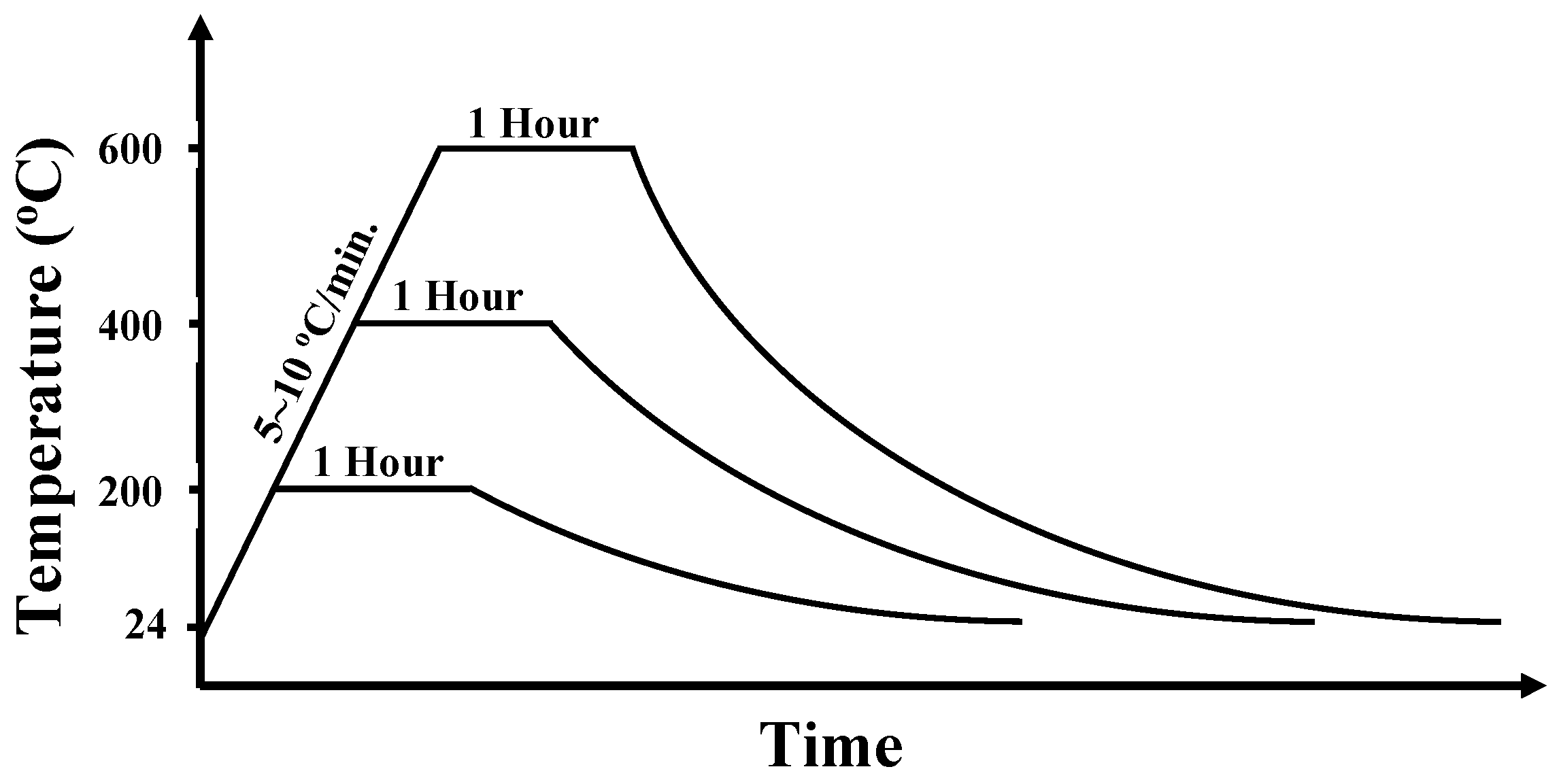

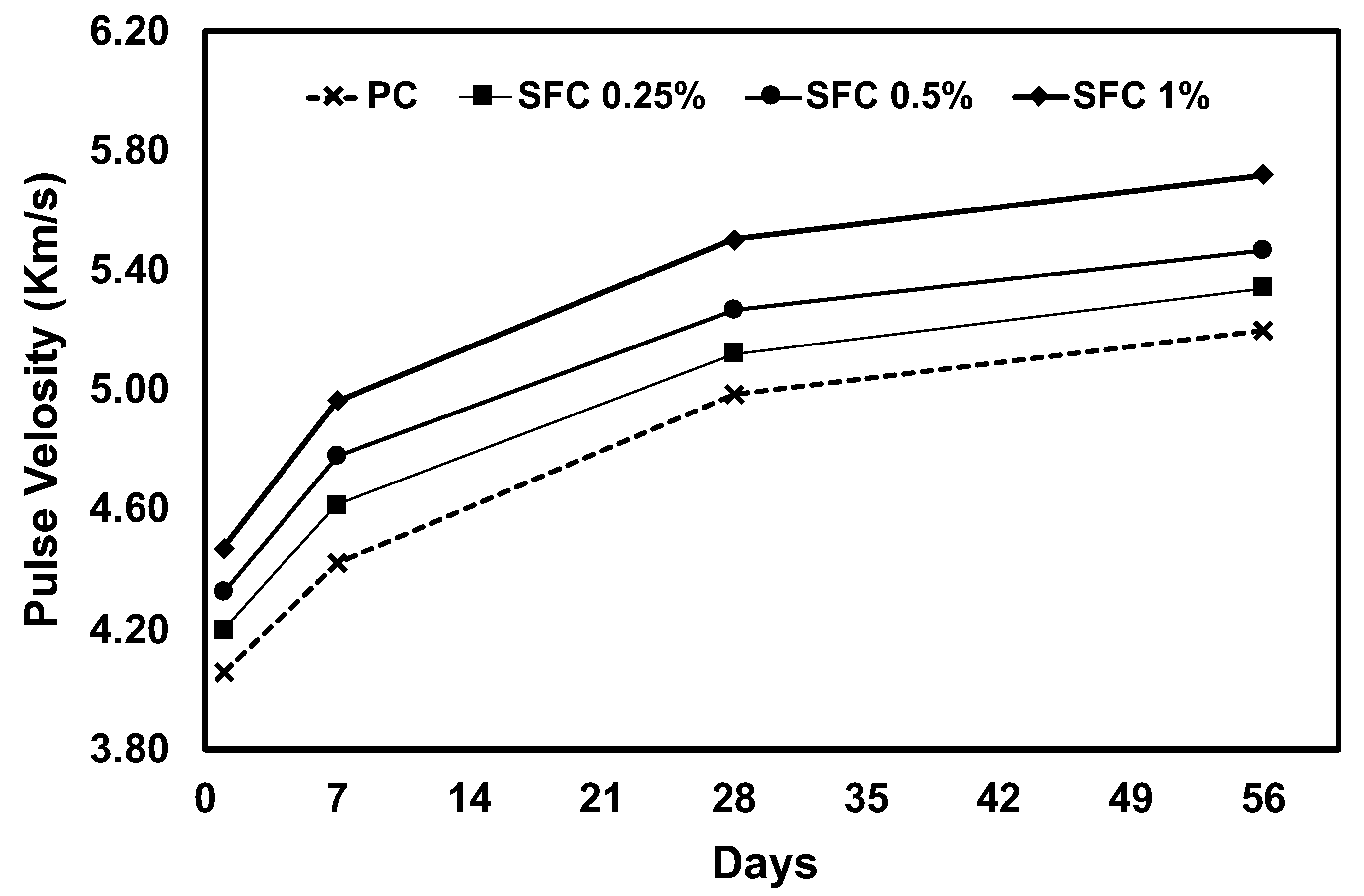
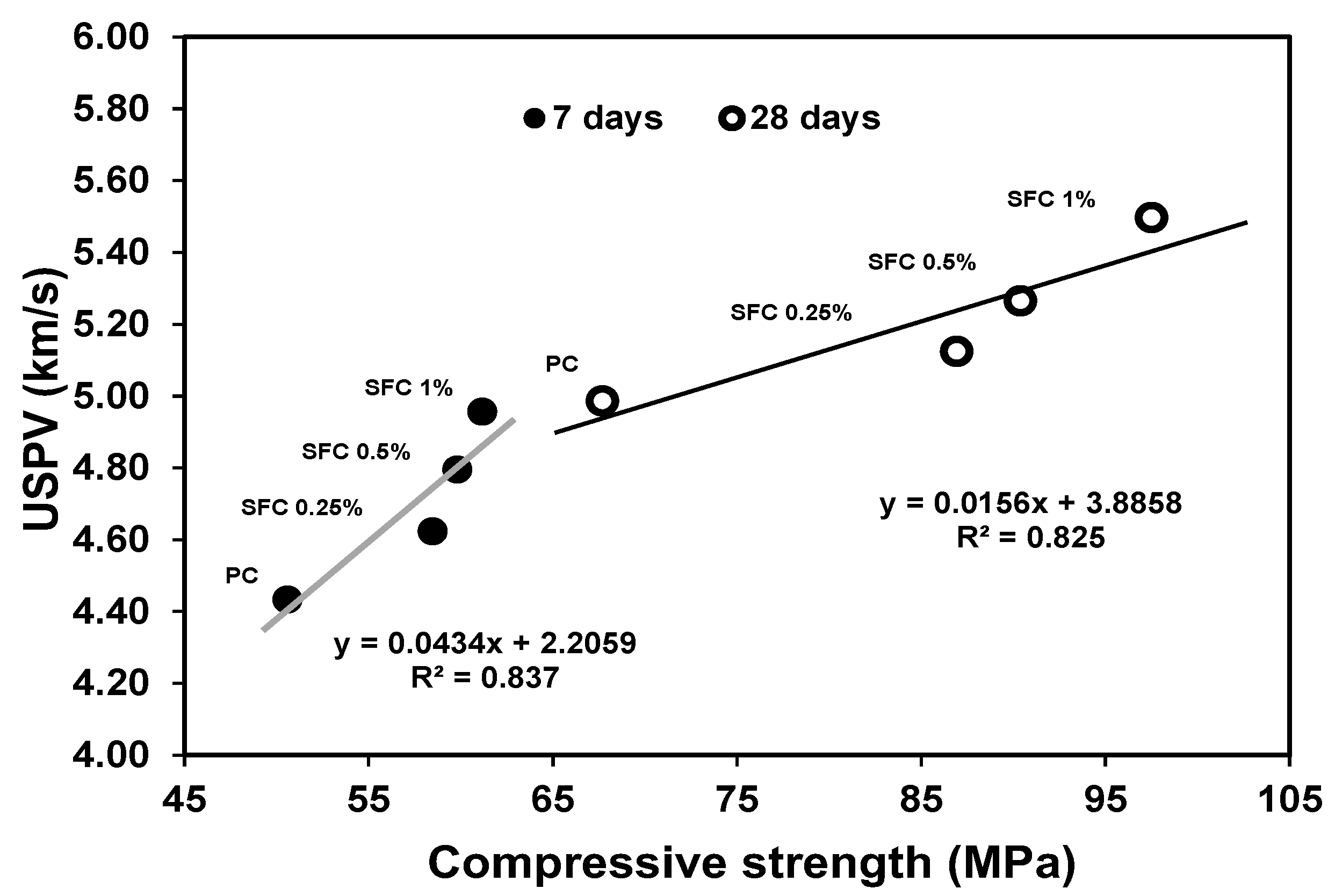


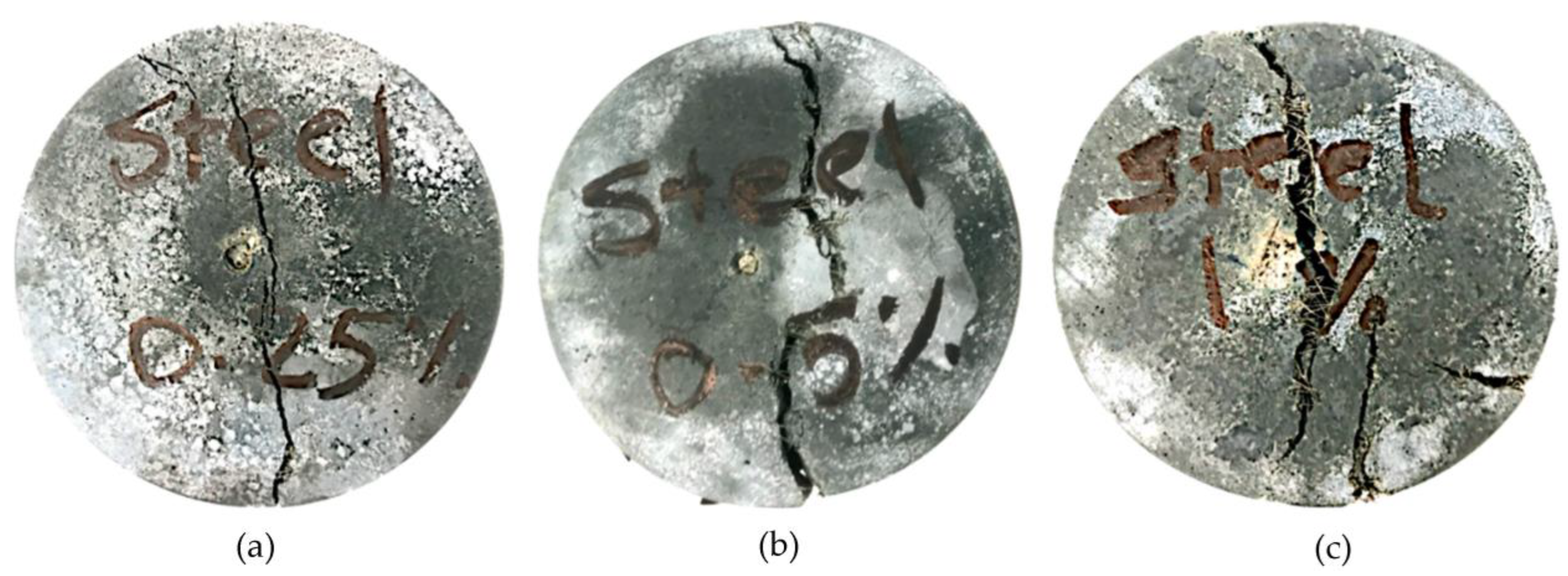
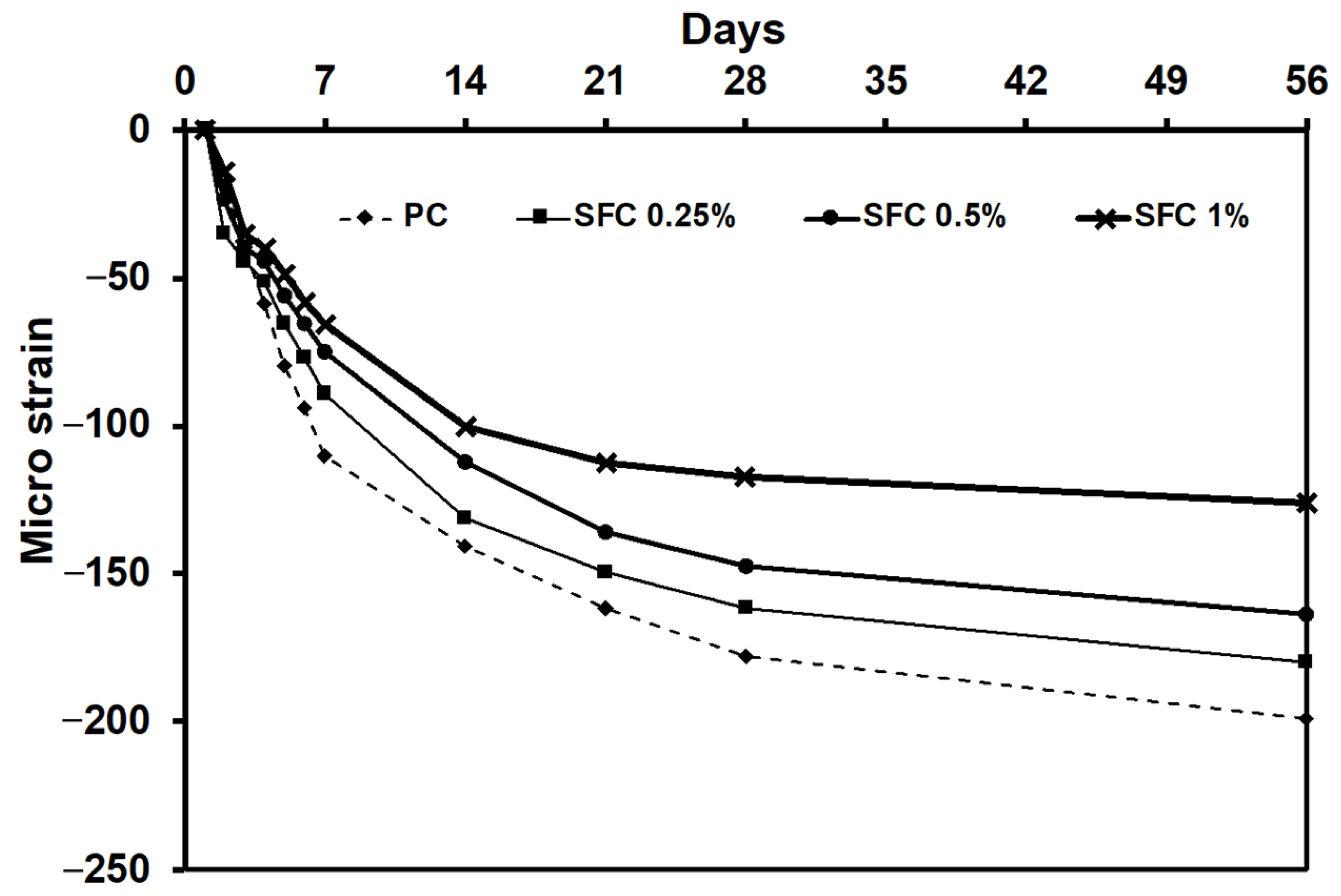
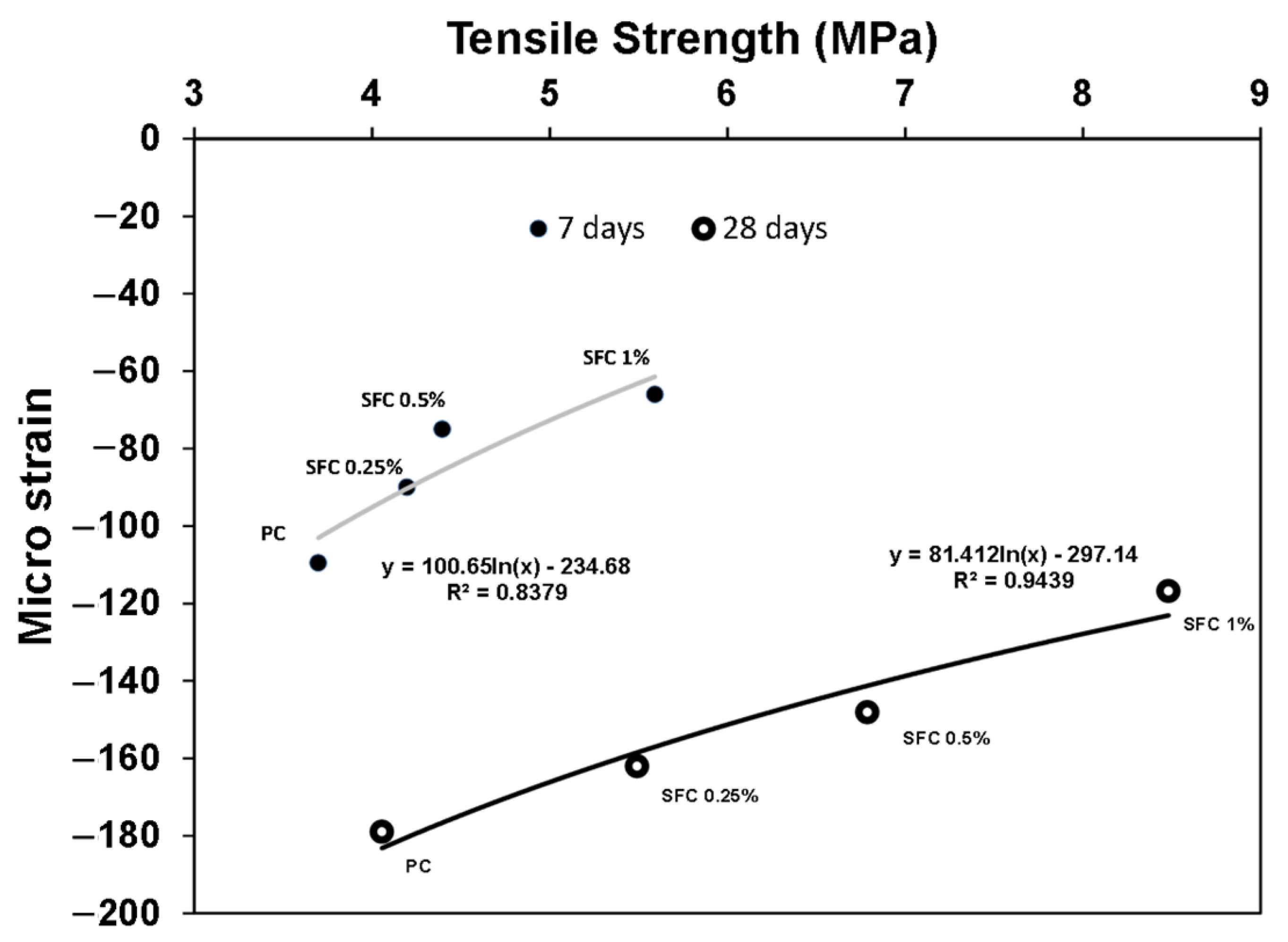

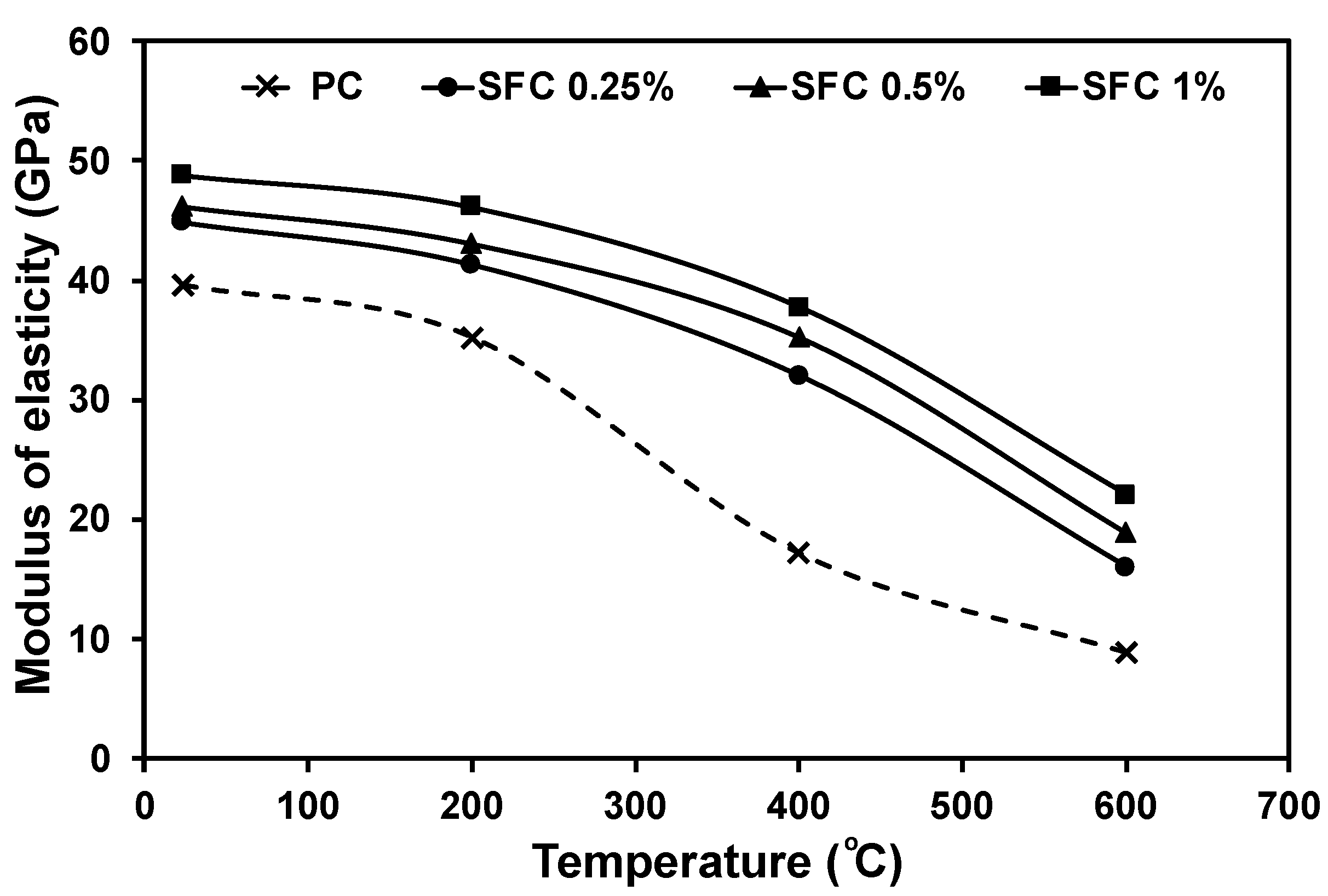
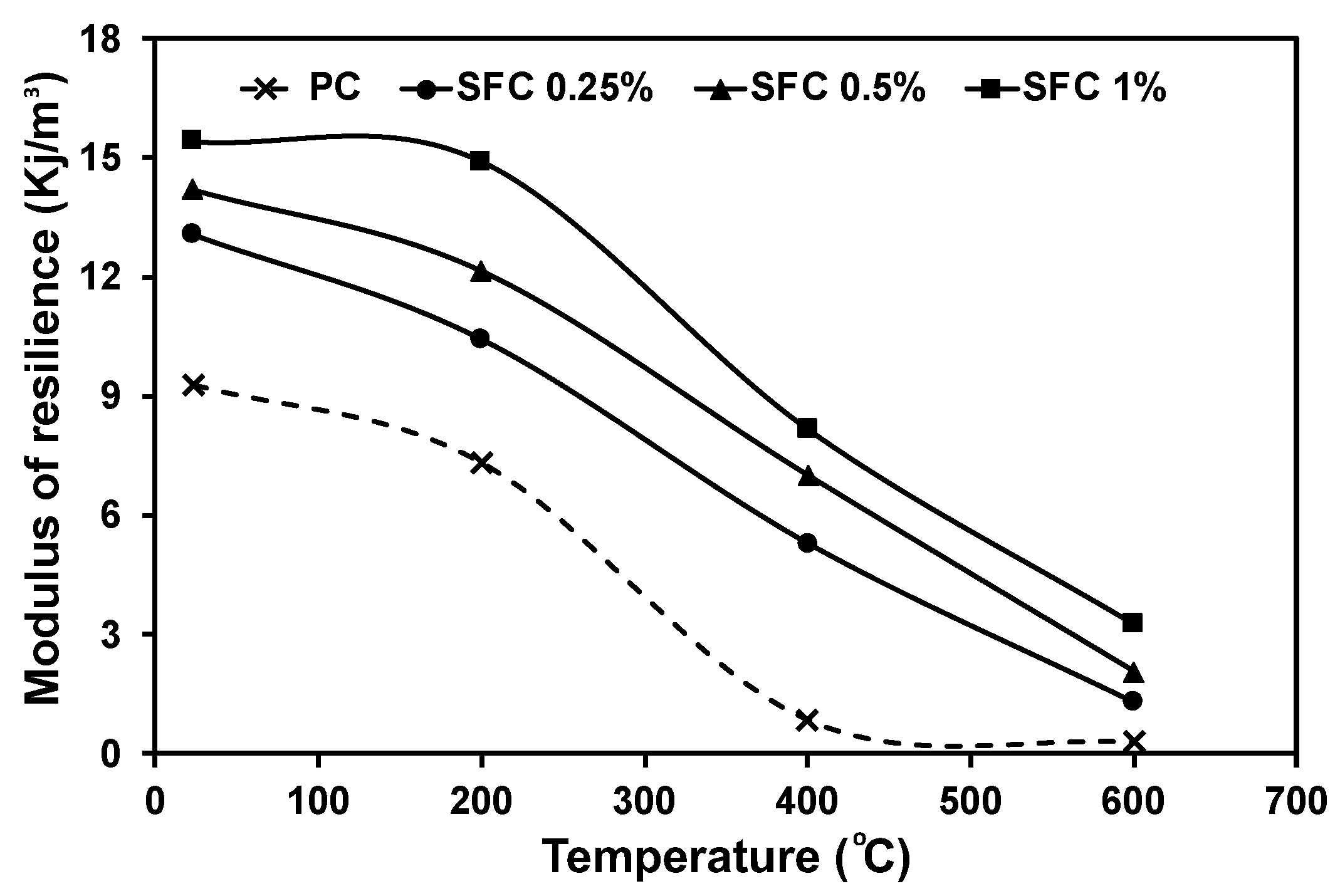
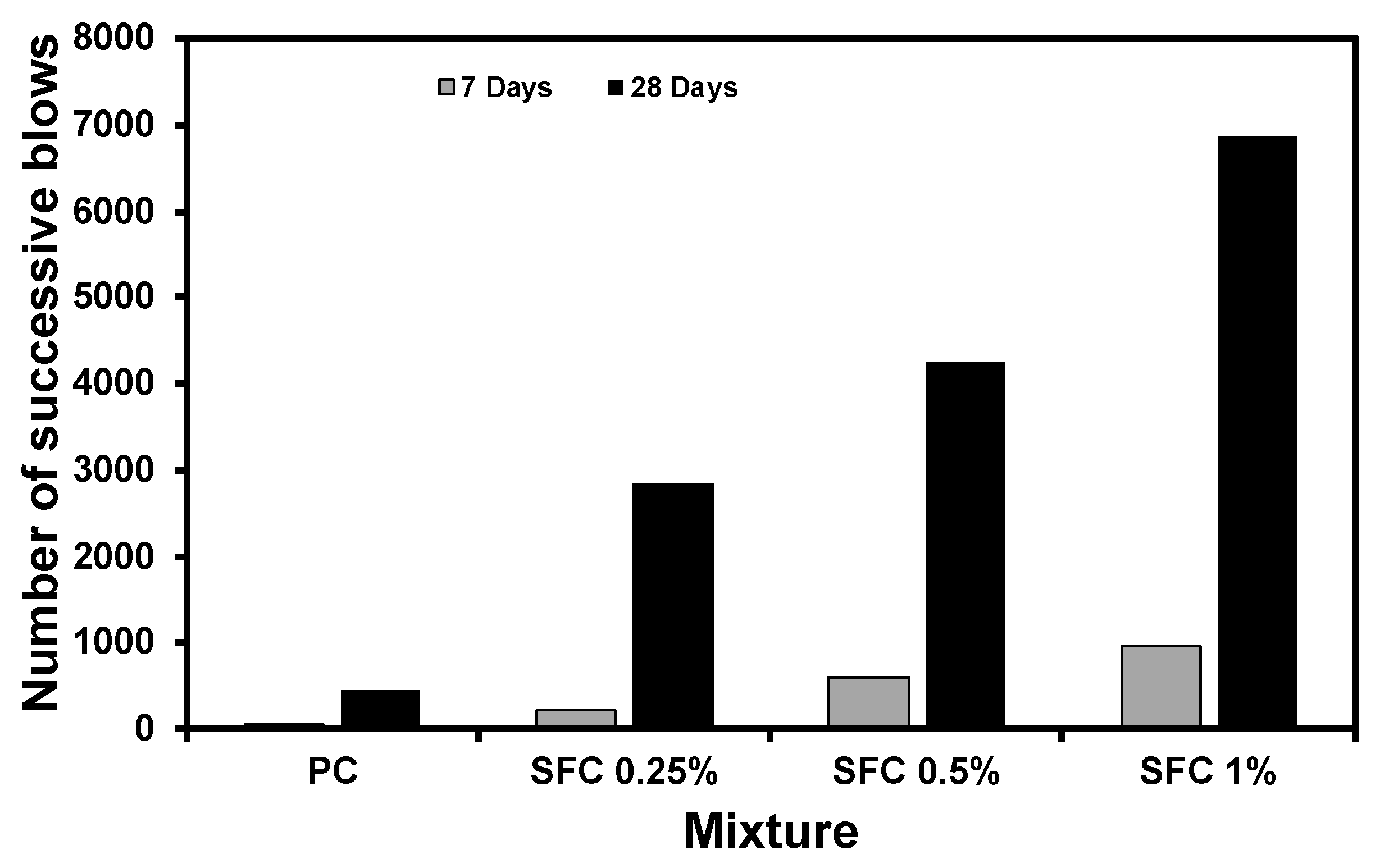
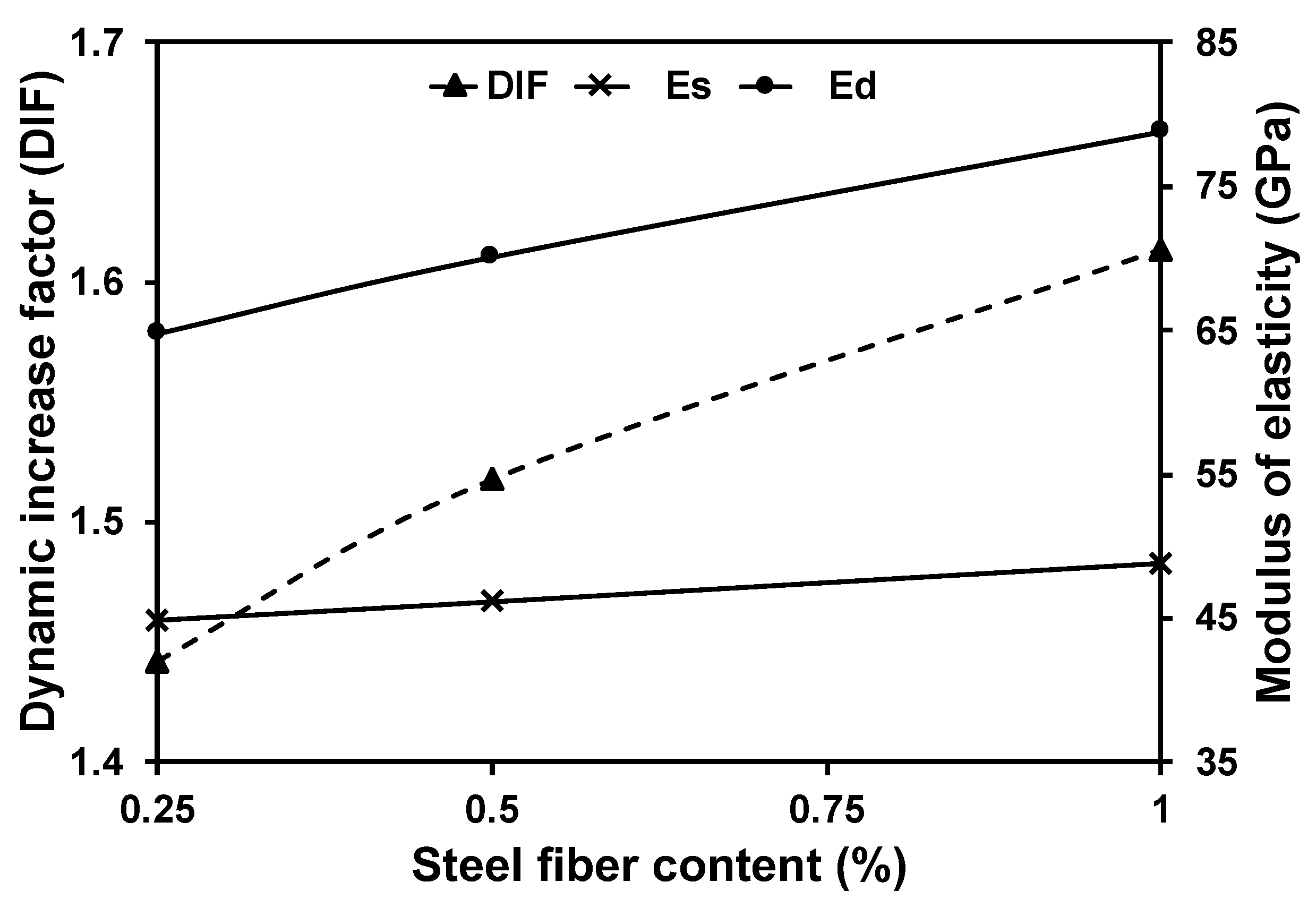
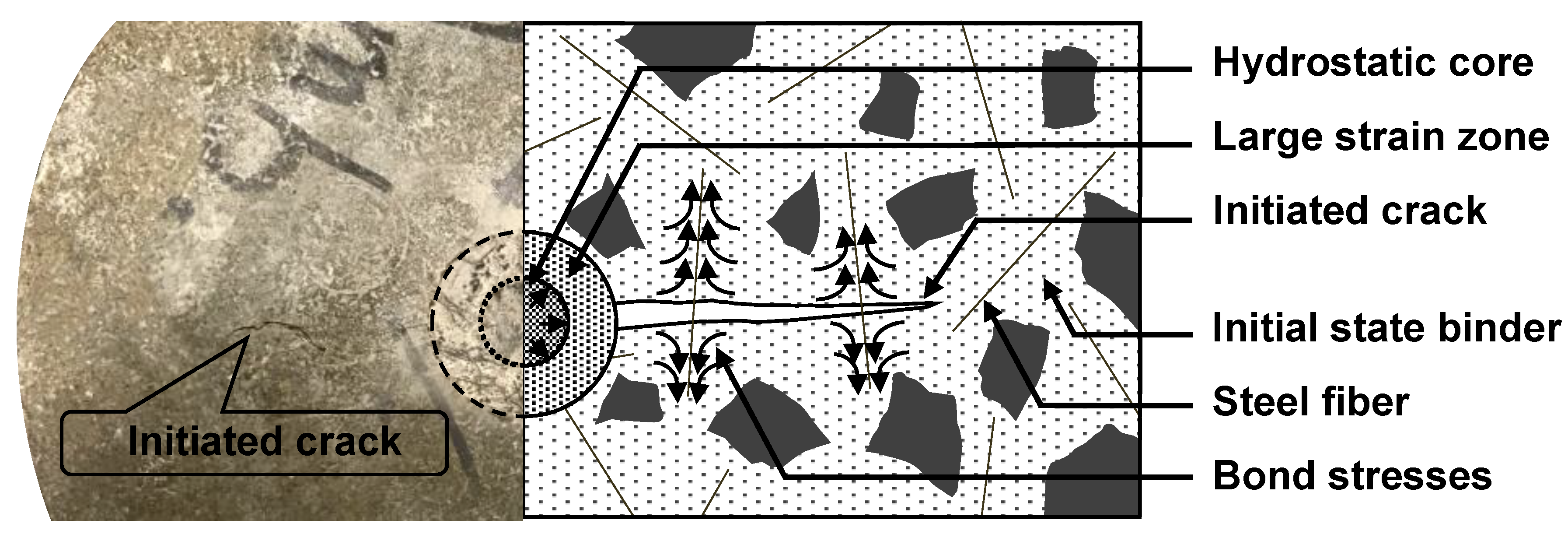
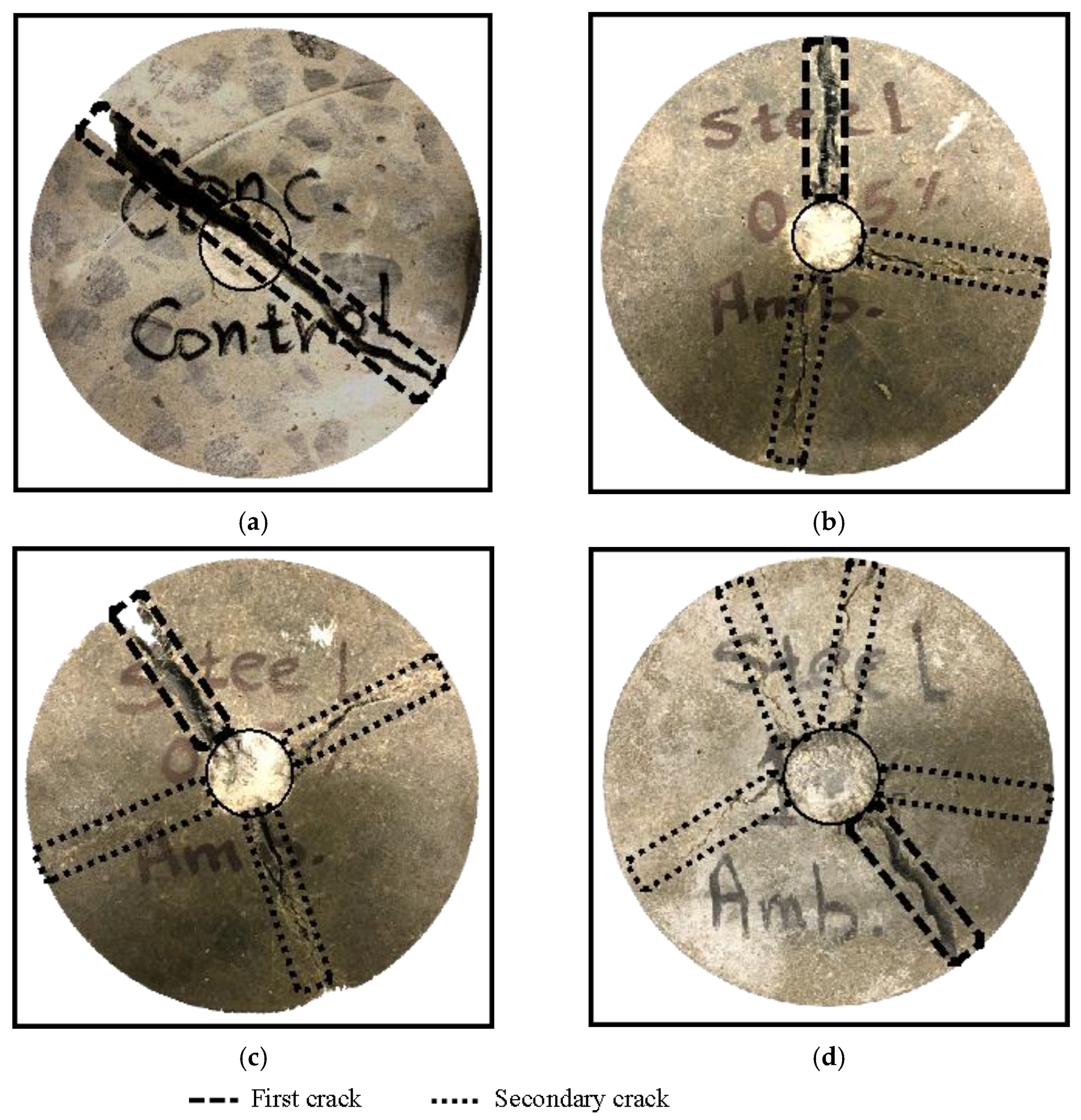
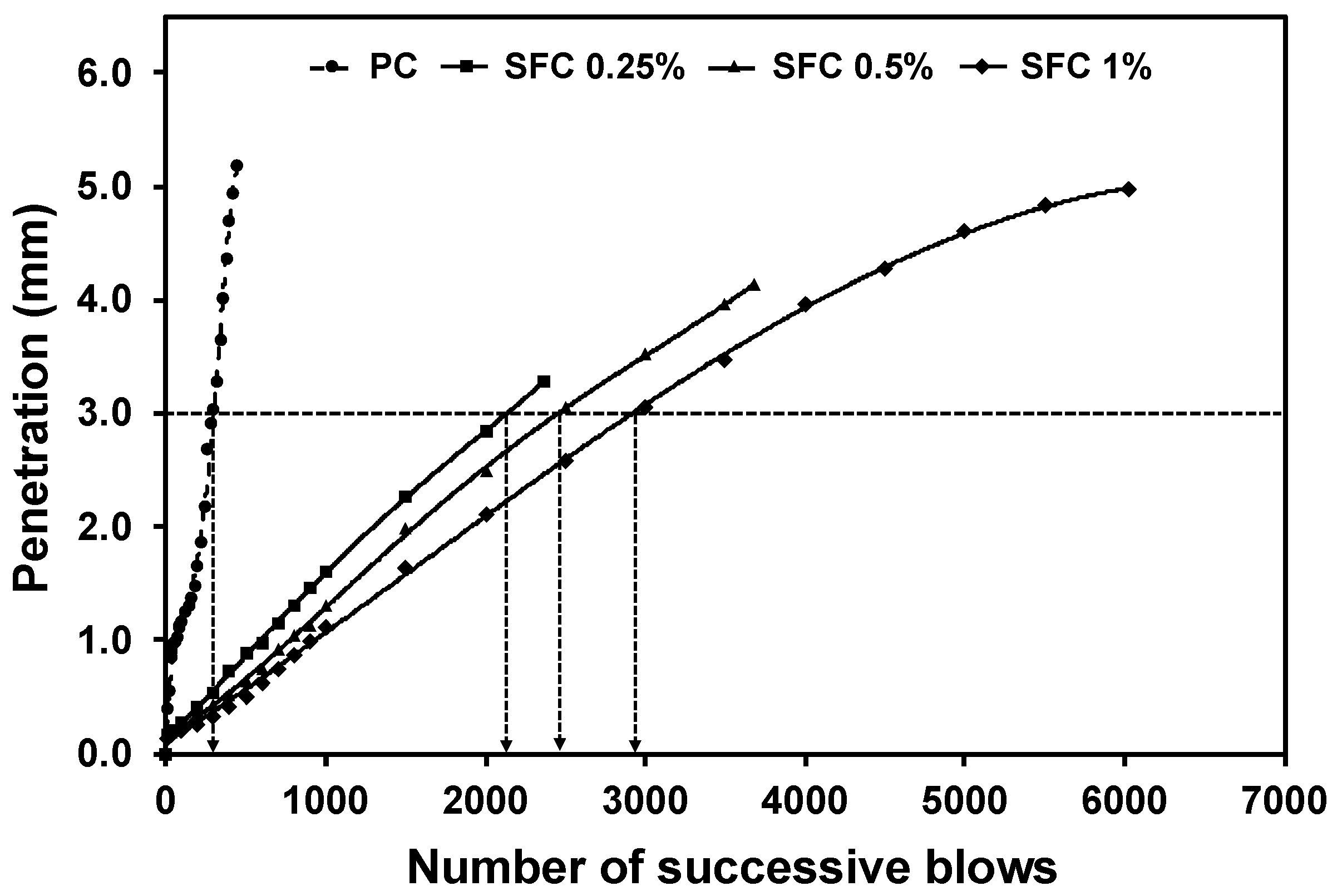
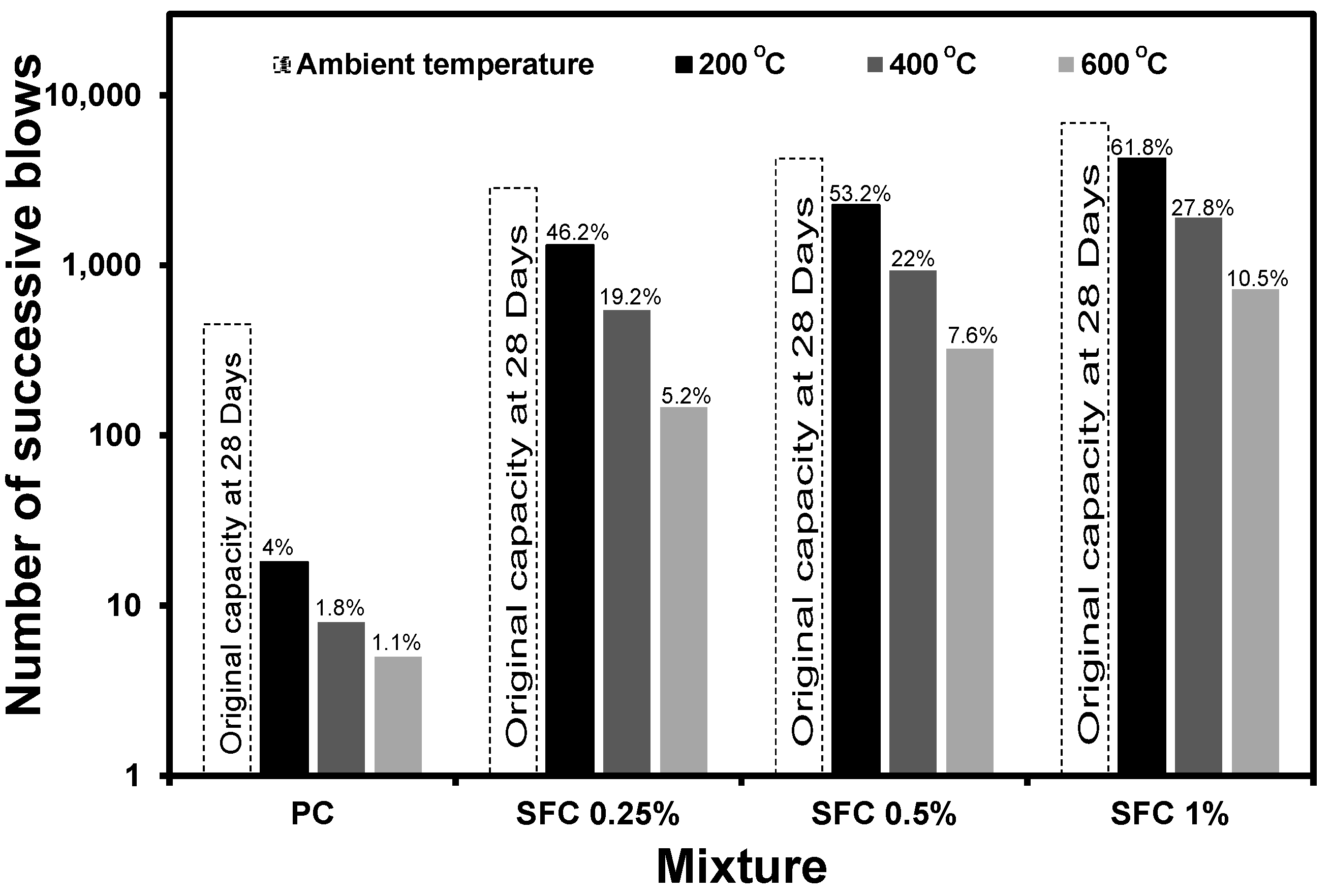
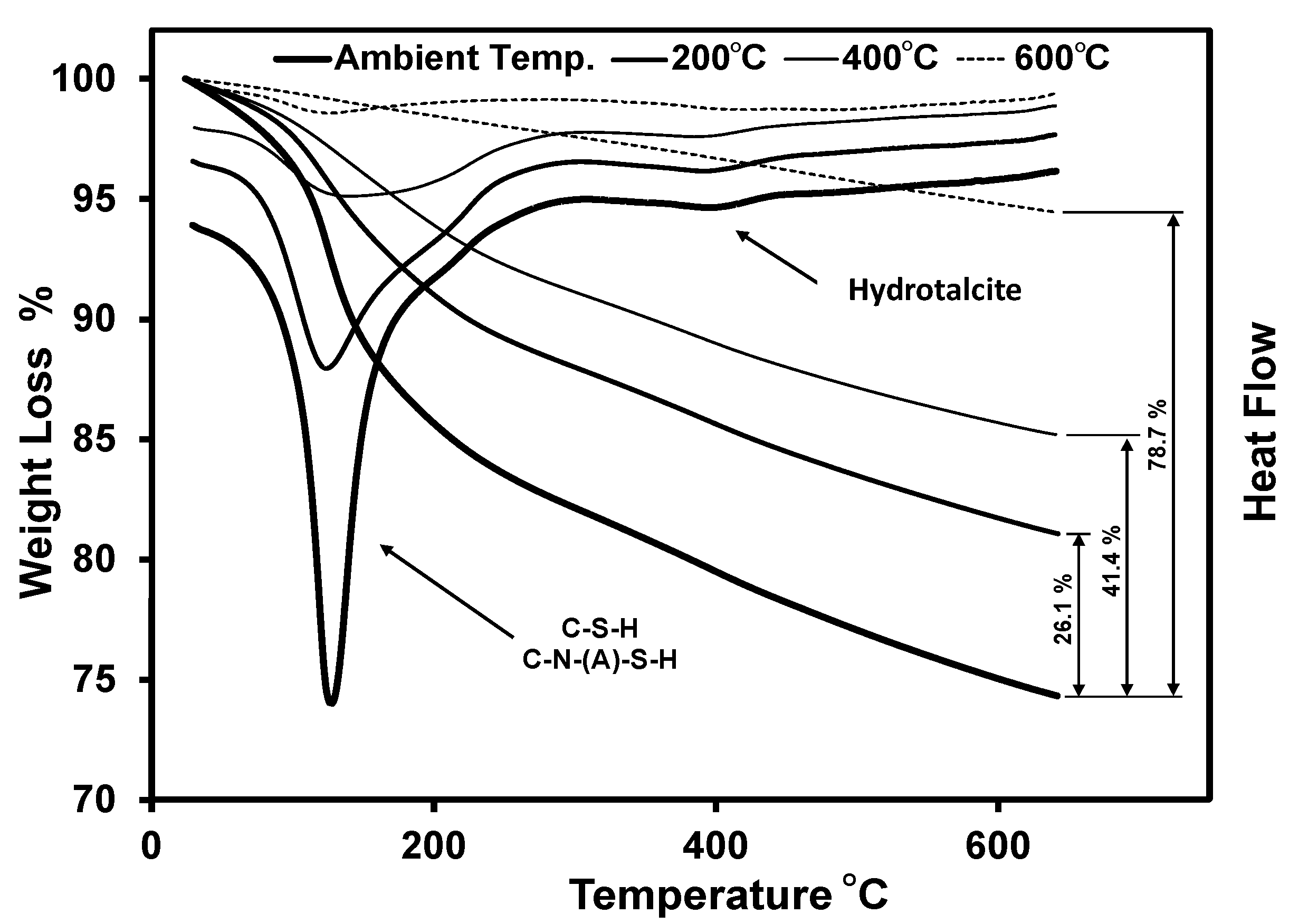

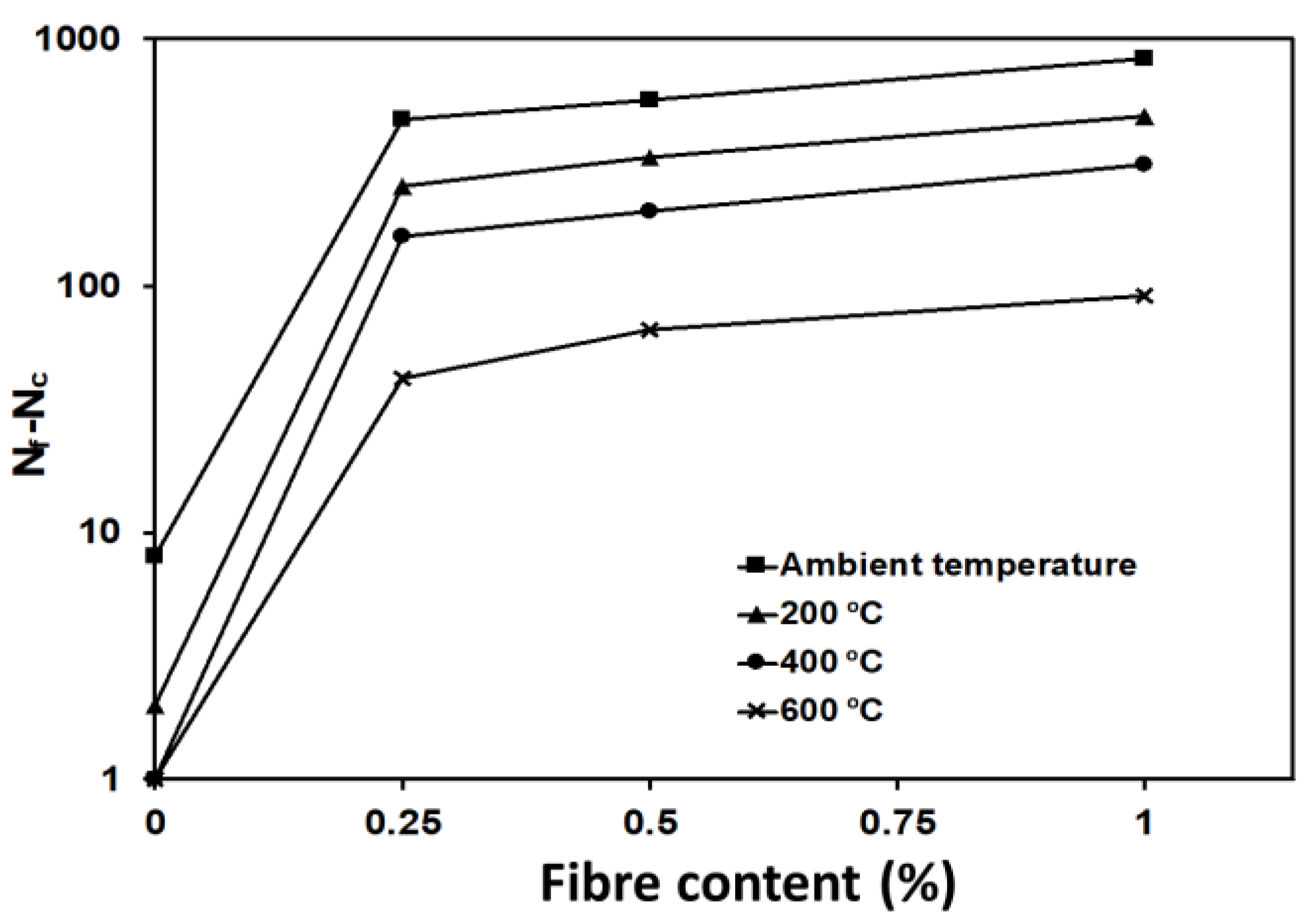
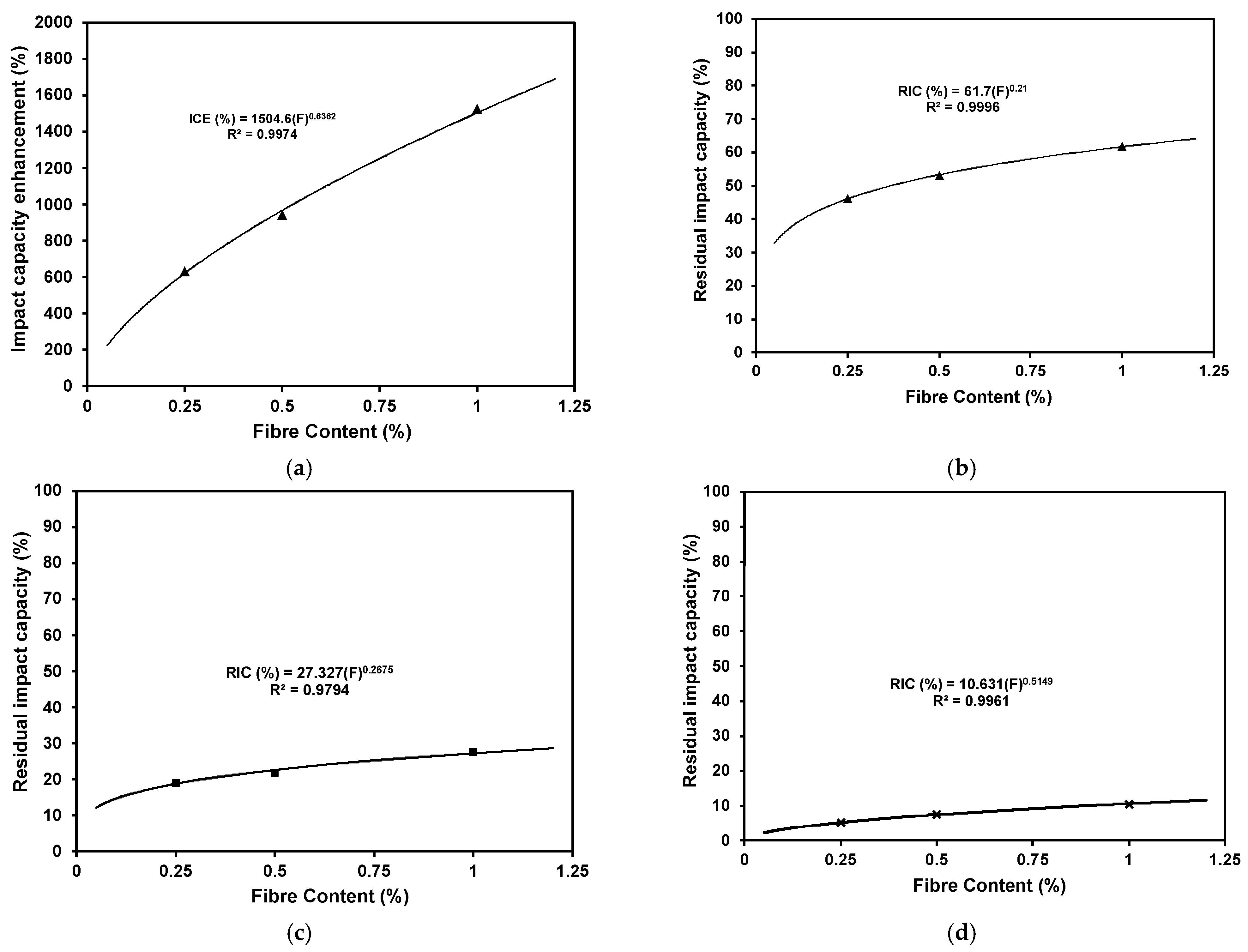
| Constituent/Property (%) | Slag |
|---|---|
| SiO2 | 36.1 |
| Al2O3 | 10.1 |
| CaO | 37 |
| MgO | 12 |
| K2O | 0.5 |
| Na2O | 0.4 |
| Fe2O3 | 0.7 |
| SO3 | 3 |
| Other Minor Elements | 0.2 |
| Mixture | Slag (kg/m3) | Fine agg. (kg/m3) | Coarse agg. (kg/m3) | Steel Fibre by Volume (%) | Steel Fibre (kg/m3) | NaOH (kg/m3) | Na2SiO3 (kg/m3) | Water (L/m3) |
|---|---|---|---|---|---|---|---|---|
| PC | 400 | 650 | 1137.5 | 0 | 0 | 21.9 | 166.8 | 72.2 |
| SFC 0.25% | 399 | 648.4 | 1134.7 | 0.25 | 19.625 | 21.85 | 166.4 | 72.1 |
| SFC 0.5% | 398 | 646.8 | 1131.8 | 0.50 | 39.25 | 21.8 | 165.9 | 71.9 |
| SFC 1% | 396 | 643.5 | 1126.2 | 1.00 | 78.50 | 21.7 | 165.1 | 71.5 |
| Mixture | Number of Blows at the First Crack (Nc) | Number of Blows at Failure (Nf) | ||||||
|---|---|---|---|---|---|---|---|---|
| 28 Days | 200 °C | 400 °C | 600 °C | 28 Days | 200 °C | 400 °C | 600 °C | |
| PC | 442 | 16 | 7 | 4 | 450 | 18 | 8 | 5 |
| SFC 0.25% | 2366 | 1056 | 386 | 104 | 2840 | 1312 | 544 | 146 |
| SFC 0.5% | 3678 | 1922 | 732 | 258 | 4244 | 2256 | 934 | 328 |
| SFC 1% | 6024 | 3748 | 1594 | 628 | 6860 | 4240 | 1904 | 720 |
Disclaimer/Publisher’s Note: The statements, opinions and data contained in all publications are solely those of the individual author(s) and contributor(s) and not of MDPI and/or the editor(s). MDPI and/or the editor(s) disclaim responsibility for any injury to people or property resulting from any ideas, methods, instructions or products referred to in the content. |
© 2023 by the authors. Licensee MDPI, Basel, Switzerland. This article is an open access article distributed under the terms and conditions of the Creative Commons Attribution (CC BY) license (https://creativecommons.org/licenses/by/4.0/).
Share and Cite
Abubakr, A.; Soliman, A. Impact Behaviour of Steel-Fibre-Reinforced Alkali-Activated Slag Concrete Exposed to Elevated Temperatures. Materials 2023, 16, 4096. https://doi.org/10.3390/ma16114096
Abubakr A, Soliman A. Impact Behaviour of Steel-Fibre-Reinforced Alkali-Activated Slag Concrete Exposed to Elevated Temperatures. Materials. 2023; 16(11):4096. https://doi.org/10.3390/ma16114096
Chicago/Turabian StyleAbubakr, Ahmed, and Ahmed Soliman. 2023. "Impact Behaviour of Steel-Fibre-Reinforced Alkali-Activated Slag Concrete Exposed to Elevated Temperatures" Materials 16, no. 11: 4096. https://doi.org/10.3390/ma16114096






